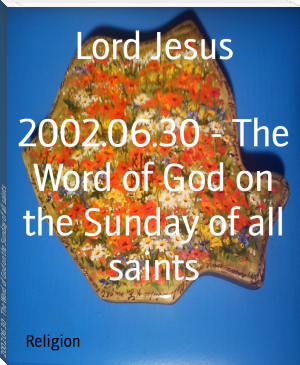The Latin & Irish Lives of Ciaran, Anonymous [best memoirs of all time .txt] 📗

- Author: Anonymous
Book online «The Latin & Irish Lives of Ciaran, Anonymous [best memoirs of all time .txt] 📗». Author Anonymous
INTRODUCTION
Of all the saints of Ireland, whose names are recorded in the native Martyrologies, probably there were none who made so deep an impression upon the minds of their fellow-countrymen as did Ciaran[1] of Clonmacnois. He stands, perhaps, second only to Brigit of Kildare in this respect; for Patrick was a foreigner, and Colum Cille accomplished his work and exercised his influence outside the shores of Ireland.
Doubtless much of the importance of Ciaran is reflected back from the outstanding importance of his great foundation-the monastic university, as it is fair to call it, of Cluain maccu Nois (in an English setting spelt "Clonmacnois"), on the shore of the Shannon. But this cannot be the whole explanation of the esteem in which he was held; it must be at least partly due to the memory of his own character and personality.
Such a conclusion is indicated if we examine critically the Lives of this saint, translations of which are given in the present volume, and compare them with the lives of other Irish saints. In studying all these documents we must bear in mind that none of them are, in any modern sense of the word, biographies. A biography, in the proper definition of the term, gives an ordered account of the life of its subject, with dates, and endeavours to trace the influences which shaped his character and his career, and the manner in which he himself influenced his surroundings. The so-called lives of saints are properly to be regarded as homilies . They were composed to be read to assemblies of the Faithful, as sermons for the festivals of the saints with whom they deal; and their purpose was to edify the hearers by presenting catalogues of the virtues of their subjects, and, especially, of their thaumaturgic powers. Thus they do not possess the unity of ordered and well-designed biographies; they consist of disconnected anecdotes, describing how this event or that gave occasion for a miraculous display.
It follows that to the historian in search of unvarnished records of actual fact these documents are useless, without most drastic criticism. They were compiled long after the time of their subjects, from tales, doubtless at first, and probably for a considerable time, transmitted by oral tradition. It would be natural that there should be much cross-borrowing, tales told about one saint being adapted to others as well, until they became stock incidents. It would also be nothing more than natural that many elements in the Lives should be survivals from more ancient mythologies, having their roots in pre-Christian beliefs. Nevertheless, none of these writings are devoid of value as pictures of life and manners; and even in descriptions of incredible and pointless miracles precious scraps of folk-lore are often embedded. In most, if not in all, cases, the incidents recorded in the Lives are to be criticised as genuine traditions, whatever their literal historicity may be; few, if any, are conscious inventions or impostures.[2]
In the Lives of Ciaran there are many conventional incidents of this kind, which reappear in the lives of other saints. In the Annotations in the present edition a few such parallels are quoted; though no attempt is made to give an exhaustive list, the compilation of which would occupy more time and space than its scientific value would warrant. But there are certain other incidents of a more individual type, and it is these which make the Lives of Ciaran especially remarkable. They may well be genuine reminiscences of the real life, or at least of the real character of the man himself. Thus, there are a number of coincidences, clearly undesigned (noted below, p. 104) consistently pointing to a pre-Celtic parentage for the saint. Again, the saint's mother is represented as a strong personality, with a decided strain of "thrawnness" in her composition; while the saint himself is shown to us as distinguished by a beautiful unselfishness. This, it must be confessed, is very far from being a common character of the Irish saints, as they are represented to us by the native hagiologists; and in any case the character-drawing of the average Irish saint's life is so rudimentary, that when we are thus enabled to detect well-defined traits, we are quite justified in accepting them as based on the tradition of the actual personality of the saint. In other words, so deep was the impression which the man made upon his contemporaries during his short life, that his memorabilia seem to be, on the whole, of a more definitely historic nature than are those of other Irish saints.
There is, however, a disturbing element which must be kept in mind in criticising the Lives of Ciaran. He was the son of a carpenter, and he was said to have died at the age of thirty-three. It is quite clear that these coincidences with the facts of the earthly parentage and death of Christ were observed by the homilists-indeed the author of the Irish Life says as much, at the end of his work. They provoked a natural and perhaps wholly unconscious desire to draw other parallels; and if we may use a convenient German technical term, there is a traceable Tendenz in this direction, as is indicated in the Annotations on later pages. It is not to be supposed that even these apparently imitative incidents are (not to mince matters) mere pious frauds; they may well have come into existence in the folk-consciousness automatically, before they received their present literary form. But such a development could hardly have centred in an unworthy subject; there must have been a well-established tradition of a Christ-likeness of character in the man, for such parallels in detail to have taken shape.[3]
The homiletic purpose of these documents is most clearly shown in the Irish Life. This was written to be preached as a sermon on the saint's festival ["this day to-day ," § 1], at Clonmacnois ["he came to this town ," § 34: "a fragment of the cask remained here till recently," § 36: " here are the relics of Ciaran," § 41. Similarly the First Latin Life, § 35, calls the saint " Our most holy patron"]. The actual date of the Irish sermon is less easy to fix; the language has been modernised step by step in the process of transmission from manuscript to manuscript, but originally it may have been written about the eleventh century, though incorporating fragments of earlier material. The passage just quoted, saying that a certain relic had remained till recently , may possibly indicate that the homily had been delivered shortly after one of the many burnings and plunderings which the monastery suffered; in such a calamity the relic might have perished. The prophecy put into Ciaran's mouth, that "there would be great persecution of his city from evil men in the end of the world" [Irish Life, § 38] seems to relate to such an event: it is very suggestive that exactly the same exprestion "great persecution from evil men" ( ingrem mór ó droch-daoinibh ) is used in the Chronicon Scotorum of certain raids on the monastery which took place in the year A.D. 1091; and that on the strength of an old prophecy there was a belief in Ireland that the world was destined to come to an end in the year 1096, as we learn from the Annals of the Four Masters under that date.[4] It must, however, be remembered that a date determined for a single incident does not necessarily date the whole compilation containing it.
The text of the First Latin Life (here called for convenience of reference LA) is found in an early fifteenth-century MS. in Marsh's Library, Dublin. It has been edited, without translation, by the Rev. C. Plummer in his most valuable Vitae Sanctorum Hiberniae (Oxford, 1910) vol. i, pp. 200-216. The translation given in this volume has been made from Plummer's edition, which I have collated with the original MS.[5]
The text of the Second Latin Life (LB) is contained in two MSS. in the Bodleian Library (Rawl. B 485 and Rawl. B 505, here called R1 and R2). Of these R2 is a direct copy of R1, as has been proved by Plummer, in his description of these manuscripts.[6] As to their date, there is no agreement; the estimate for R1 ranges from the first half of the thirteenth to the fourteenth century, R2 being necessarily somewhat later. The Life of Ciaran contained in these MSS. has been used by Plummer in editing LA, and extracts from it are printed in his footnotes. It has not, however, been previously printed in its entirety, and a transcript made by myself is therefore added here, in an Appendix.
The text of the Third Latin Life (LC) is contained in the well-known Brussels MS., called Codex Salmaticensis from its former sojourn at Salamanca. It is of the fourteenth century. This was the only continuous authority at the disposal of the compiler of the Bollandist life of our saint; he speaks of it in the most contemptuous terms. The life of Ciaran in this manuscript is a mere fragment, evidently copied from an imperfect exemplar; there seems to have been a chasm in the middle, and there is a lacuna at the end, which the scribe has endeavoured to conceal by adding the words "Finit, Amen." The translation here given has been prepared from the edition of the Salamanca MS. by de Smedt and de Backer, cols. 155-160.
The Irish Life (here denoted VG, i.e. Vita Goedelica ) was edited by Whitley Stokes from the late fifteenth-century MS. called the Book of Lismore. [7] The numerous errors in the Lismore text may be to some extent corrected by collation with another Brussels MS., written in the seventeenth century by Micheál ó Cléirigh. Stokes has indicated the more important readings of the Brussels MS. in his edition. The scribe of the Lismore Text was conscious of the defects of his copy: for in a note appended to the Life of our saint, he says, "It is not I who am responsible for the meaningless words in this Life , but the bad manuscript"- i.e. the imperfect exemplar of which he was making a transcript.
There were other Lives of the saint in existence, apparently no longer extant. Of these, one was in the hands of the hagiographer Sollerius: for in his edition of the Martyrologium of Usuardus (Antwerp, 1714, p. 523) he says, Querani, Kirani, uel Kiriani uitam MS. habemus. uariaque ad eam annotata, quae suo tempore digerentur . This promise he does not appear to have fulfilled; the Bollandist compiler, as we have just noticed, had no materials but the imperfect Salamanca Life, and was forced to fill its many gaps as best he could, by diligently collecting references to Ciaran in the lives of other saints. Another Life of the saint seems to be referred to in the Martyrology of Donegal ; under the 10th May that compilation quotes a certain "Life of Ciaran of Cluain" ( i.e. Clonmacnois) as the authority for a statement to the effect that "the order of Comgall [of Bangor, Co. Down] was one of the eight orders that were in Ireland." It would be irrelevant to discuss here the meaning of this statement; its importance for us lies in the fact that the sentence is not found in any of the extant Lives, so that some other text, now unknown, must be in question.





Comments (0)